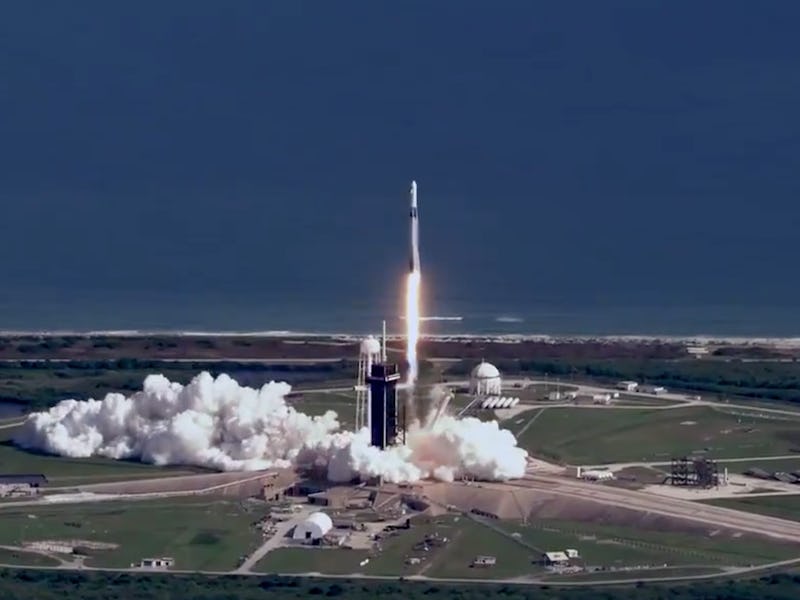SpaceX Falcon 9 launch video from helicopter gives a stunning perspective
SpaceX's 100th successful Falcon 9 launch has been captured in impressive detail.

The Falcon 9, the booster that has transformed SpaceX into an industry giant, has completed its 100th successful launch. Following the landmark event, CEO Elon Musk shared impressive video footage that shows the event from an unusual angle.
SUBSCRIBE TO MUSK READS+, A PREMIUM NEWSLETTER THAT COVERS THE WORLDS OF ELON MUSK, SPACEX, TESLA, AND EVERYTHING BETWEEN.
The launch, which took place Sunday at 11:17 a.m. Eastern, sent up the 21st Commercial Resupply Services mission for NASA. The capsule, packed with scientific experiments and other cargo for the International Space Station, lifted off from Launch Complex 39-A at the Kennedy Space Center in Florida. Following the launch, the booster successfully landed on the Of Course I Still Love You droneship.
The moment symbolized how SpaceX has transformed from a small-scale rocket launcher to a key player in the industry. The firm managed its first successful launch in 2008 with the Falcon 1, its only successful launch that year. This year SpaceX has launched 24 missions, more than any other year, and 19 of those missions used previously-flown boosters.
Following the launch, SpaceX shared impressive footage that showed the booster at the moment of liftoff. The video was subsequently retweeted by Musk to his 40 million followers. The video, taken from a helicopter, tracks the rocket soaring into the sky and lifting off away from the ground.
SpaceX also shared five new photos of the launch via its Flickr account.
SpaceX's rocket taking off.
This was SpaceX's 100th successful Falcon 9 mission and 102nd overall. A failed mission in 2015 was meant to send supplies to the space station, but the rocket instead started to break up two minutes after launch. Another failed mission in 2016 incinerated Spacecom and Facebook's AMOS-6 communications satellite at the launch site.
Zooming off in front of the SpaceX logo.
While these cargo missions for the International Space Station have become almost commonplace, this one was unlike others. It marked the debut of an upgraded Dragon capsule: where the original was certified for three flights per capsule, the new version can take on five flights total. The new version can also carry 50 percent more payload of science experiments than the previous version.
A close-up shot of the launch.
This was the booster's fourth flight, having flown on three previous missions:
- The first launch, on May 30, 2020, sent up NASA astronauts Bob Behnken and Doug Hurley in SpaceX's first crewed mission.
- The second, on July 20, 2020, launched the ANASIS-II mission for a communications satellit.
- The third, on October 6, 2020, launched the 13th batch of Starlink satellites. The mission added to SpaceX's ever-expanding internet connectivity constellation.
The trail behind the booster.
The capsule contains a wealth of supplies to support scientific missions. One notable inclusion is the Namrocks Bishop Airlock, which NASA describes as the first commercially owned and operated airlock.
Following the launch, the capsule is expected to autonomously dock with the space station at around 1:30 p.m. Eastern time on Monday. This will also be the first time that two Dragon capsules have been attached to the space station at the same time: the "Resilience" capsule from the four-astronaut "Crew-1" mission has been docked to the station since November 16.
The rocket rising into the sky.
The new capsule is set to stay at the station for around a month, returning to Earth after its stay with 5,200 pounds of cargo.
The Inverse analysis — SpaceX's latest launch continues its warm relationship with NASA, albeit one that's had its ups and downs. It's perhaps fitting that SpaceX, as an important force in bringing private companies into the space race, is launching the station's first commercially-operated airlock as part of this mission.
The company's strong social media presence means videos like these are a big hit with fans. At the time of writing, the helicopter video has nearly one million views. Musk, who also shared the video with his followers, marked the occasion with a rather brief post: "100."
As SpaceX looks to sending humans to Mars and beyond, expect videos like these to form a big part of its publicity strategy.
This article was originally published on